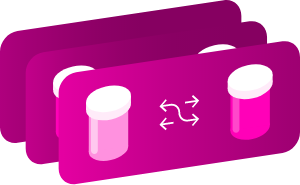Identification
- Summary
-
Asparaginase Escherichia coliis an asparaginase enzyme from E. coli used as part of treatment regimens for acute lymphoblastic leukemias.
- Brand Names
-
Rylaze, Spectrila
- Generic Name
- Asparaginase Escherichia coli
- DrugBank Accession Number
- DB00023
- Background
-
Asparaginase derived fromEscherichia coli(L-asparagine amidohydrolase, EC 3.5.1.1) is an enzyme responsible for the metabolism of L-asparagine, by catalyzing L-asparagine into L-aspartic acid and ammonia. It also facilitates the production of oxaloacetate which is needed for general cellular metabolism. Asparaginase fromE. colihas clinically shown to exhibit antitumor actions in models of leukaemias1,2. L-asparaginase ofE. coliis marketed under several different trade names, including Elspar, for the treatment of acute lymphoblastic leukemia (ALL) as part of a multi-agent chemotherapeutic regimen. It is available as intramuscular or intravenous injections. Therapeutic L-asparaginase fromE. coliworks by depleting the levels of non-essential amino acid, asparagine, in lymphoblastic leukemic cells thus promoting apoptotic cell death3. For patients who develop hypersensitivity toE. coli-derived formulations of L-asparaginase, the use of PEGylated or non-PEGylatedAsparaginase Erwinia chrysanthemiis recommended3.
- Type
- Biotech
- Groups
- Approved, Investigational
- Biologic Classification
-
Protein Based Therapies
Other protein based therapies - Protein Structure
-

- Protein Chemical Formula
- C1377H2208N382O442S17
- Protein Average Weight
- Not Available
- Sequences
-
>sp|P00805|ASPG2_ECOLI L-asparaginase 2 OS=Escherichia coli (strain K12) GN=ansB PE=1 SV=2 MEFFKKTALAALVMGFSGAALALPNITILATGGTIAGGGDSATKSNYTVGKVGVENLVNA VPQLKDIANVKGEQVVNIGSQDMNDNVWLTLAKKINTDCDKTDGFVITHGTDTMEETAYF LDLTVKCDKPVVMVGAMRPSTSMSADGPFNLYNAVVTAADKASANRGVLVVMNDTVLDGR DVTKTNTTDVATFKSVNYGPLGYIHNGKIDYQRTPARKHTSDTPFDVSKLNELPKVGIVY NYANASDLPAKALVDAGYDGIVSAGVGNGNLYKSVFDTLATAAKTGTAVVRSSRVPTGAT TQDAEVDDAKYGFVASGTLNPQKARVLLQLALTQTKDPQQIQQIFNQY
Download FASTA Format - Synonyms
-
- Asparaginase
- Asparaginase (E. coli)
- Colaspase
- Escherichia coli L-asparaginase
- L-asparaginase
- L-asparagine amidohydrolase
Pharmacology
- Indication
-
Indicated as a component of a multi-agent chemotherapeutic regimen for the treatment of patients with acute lymphoblastic leukemia (ALL).5
 Reduce drug development failure ratesBuild, train, & validate machine-learning models
Reduce drug development failure ratesBuild, train, & validate machine-learning models
with evidence-based and structured datasets.Build, train, & validate predictive machine-learning models with structured datasets. - Associated Conditions
- Contraindications & Blackbox Warnings
-
 Avoid life-threatening adverse drug eventsImprove clinical decision support with information oncontraindications & blackbox warnings, population restrictions, harmful risks, & more.Avoid life-threatening adverse drug events & improve clinical decision support.
Avoid life-threatening adverse drug eventsImprove clinical decision support with information oncontraindications & blackbox warnings, population restrictions, harmful risks, & more.Avoid life-threatening adverse drug events & improve clinical decision support. - Pharmacodynamics
-
In clinical trials of patients with previously untreated, standard-risk ALL, administration of asparaginase resulted in a decrease of plasma asparagine levels from average of 41 μM to less than 3 μMLabel. The native asparaginase in whom plasma enzyme activity before treatment was greater than 0.1 International Units/mLLabel. In this study, cerebrospinal fluid asparagine levels in patients treated with asparaginase decreased from 2.8 μM (pretreatment) to 1.0 μM and 0.3 μM at day 7 and day 28 of induction, respectivelyLabel. Native E. coli asparaginase results in asparagine depletion in 14 to 23 days following administration3.
- Mechanism of action
-
天冬酰胺是一种非必需氨基酸,主要tains DNA, RNA and protein synthesis and promotes cell growth. While healthy and normal cells are capable of obtaining asparagine via dietary intake or synthesizing the asparagine from aspartate via asparagine synthetase activity, lymphoblastic leukemic cells lack the asparagine synthetase enzyme and cannot produce asparaginede novo3. Thus, leukemic cells rely on exogenous source of asparagine for protein synthesis and cell survival3. L-asparagine from E. coli serves to deplete plasma levels of asparagine in leukemic cells by converting L-asparagine to L-aspartic acid and ammonia3, leading to reduced reduced DNA, RNA and protein synthesis; inhibition of cell growth; and ultimately the activation of apoptotic cell-death mechanisms3. Normal cells, however, are able to synthesize asparagine and thus are affected less by the rapid depletion produced by treatment with the enzyme asparaginaseLabel.
Target Actions Organism AL-asparagine other/unknownHumans - Absorption
-
In a study in patients with metastatic cancer and leukemia, daily intravenous administration of L-asparaginase derived fromE. coliresulted in a cumulative increase in plasma levels. Following intramuscular injection in patients with metastatic cancer and leukemia, peak plasma levels of asparaginase was achieved 14 to 24 hours post-dosingLabel.
Peak asparaginase activity of nativeE. coliasparaginase can be observed in 24 to 48 hours following administration3.
- 的体积分布
-
Apparent volume of distribution was slightly greater than the plasma volume. Asparaginase levels in cerebrospinal fluid were less than 1% of concurrent plasma levels3.
- Protein binding
-
Not Available
- Metabolism
- Not Available
- Route of elimination
-
Not Available
- Half-life
-
Plasma half life of L-asparagine derived fromE. colifollowing intravenous injection was 8-30 hrsLabel. Plasma half-life was 34 to 49 hours after intramuscular injectionLabel. Half-life (mean ± SD) of nativeE. coliasparaginase is approximately 1.28 ± 0.35 days3.
- Clearance
-
Not Available
- Adverse Effects
-
 Improve decision support & research outcomesWith structured adverse effects data, including:blackbox warnings, adverse reactions, warning & precautions, & incidence rates.Improve decision support & research outcomes with our structured adverse effects data.
Improve decision support & research outcomesWith structured adverse effects data, including:blackbox warnings, adverse reactions, warning & precautions, & incidence rates.Improve decision support & research outcomes with our structured adverse effects data. - Toxicity
-
No studies assessing the mutagenic or carcinogenic potential ofE. coliL-asparagine have been conducted. In the Ames assay, no mutagenic effect was demonstrated when tested against Salmonella typhimurium strainsLabel. No studies have been performed on impairment of fertilityLabel. Following a single, intravenous injection of 12,500 to 50,000 International Units L-asparagine/kg in rabbits, edema and necrosis of pancreatic islets were observed. The clinical relevance of this finding is unclear as it does not indicate pancreatitisLabel.
- Pathways
- Not Available
- Pharmacogenomic Effects/ADRsBrowse all" title="" id="snp-actions-info" class="drug-info-popup" href="javascript:void(0);">
- Not Available
Interactions
- Drug InteractionsLearn More" title="" id="structured-interactions-info" class="drug-info-popup" href="javascript:void(0);">
-
This information should not be interpreted without the help of a healthcare provider. If you believe you are experiencing an interaction, contact a healthcare provider immediately. The absence of an interaction does not necessarily mean no interactions exist.
Drug Interaction Integrate drug-drug
interactions in your softwareAllantoin 尿囊素可以分辨的治疗效果ased when used in combination with Asparaginase Escherichia coli. Ambroxol The risk or severity of methemoglobinemia can be increased when Asparaginase Escherichia coli is combined with Ambroxol. Articaine The risk or severity of methemoglobinemia can be increased when Asparaginase Escherichia coli is combined with Articaine. Benzocaine The risk or severity of methemoglobinemia can be increased when Asparaginase Escherichia coli is combined with Benzocaine. Benzyl alcohol The risk or severity of methemoglobinemia can be increased when Asparaginase Escherichia coli is combined with Benzyl alcohol. Bupivacaine The risk or severity of methemoglobinemia can be increased when Asparaginase Escherichia coli is combined with Bupivacaine. Butacaine The risk or severity of methemoglobinemia can be increased when Asparaginase Escherichia coli is combined with Butacaine. Butamben The risk or severity of methemoglobinemia can be increased when Asparaginase Escherichia coli is combined with Butamben. Capsaicin The risk or severity of methemoglobinemia can be increased when Asparaginase Escherichia coli is combined with Capsaicin. Carbamazepine The therapeutic efficacy of Carbamazepine can be increased when used in combination with Asparaginase Escherichia coli.  Identify potential medication risksEasily compare up to 40 drugs with our drug interaction checker.Get severity rating, description, and management advice.勒arn more
Identify potential medication risksEasily compare up to 40 drugs with our drug interaction checker.Get severity rating, description, and management advice.勒arn more - Food Interactions
- No interactions found.
Products
-
 Drug product information from 10+ global regionsOur datasets provide approved product information including:
Drug product information from 10+ global regionsOur datasets provide approved product information including:
dosage, form, labeller, route of administration, and marketing period.Access drug product information from over 10 global regions. - Brand Name Prescription Products
-
Name Dosage Strength Route Labeller Marketing Start Marketing End Region Image Elspar Injection, powder, lyophilized, for solution 10000 [iU]/1 Intramuscular; Intravenous Lundbeck Inc. 1978-01-10 2013-07-18 US Kidrolase Powder, for solution 10000 unit / vial Intramuscular; Intravenous Jazz Pharmaceuticals France Sas 1974-12-31 2021-07-07 Canada Rylaze Injection 20 mg/1mL Intramuscular Jazz Pharmaceuticals, Inc. 2021-06-30 Not applicable US Spectrila Injection, powder, for solution 10000 U Intravenous Medac Gesellschaft Fuer Klinische Spezialpraeparate Mb H 2016-09-08 Not applicable EU Spectrila Injection, powder, for solution 10000 U Intravenous Medac Gesellschaft Fuer Klinische Spezialpraeparate Mb H 2016-09-08 Not applicable EU
Categories
- ATC Codes
- L01XX02 — Asparaginase
- Drug Categories
- Chemical TaxonomyProvided byClassyfire
-
- Description
- Not Available
- Kingdom
- Organic Compounds
- Super Class
- Organic Acids
- Class
- Carboxylic Acids and Derivatives
- Sub Class
- Amino Acids, Peptides, and Analogues
- Direct Parent
- Peptides
- Alternative Parents
- Not Available
- Substituents
- Not Available
- Molecular Framework
- Not Available
- External Descriptors
- Not Available
- Affected organisms
-
- Humans and other mammals
Chemical Identifiers
- UNII
- G4FQ3CKY5R
- CAS number
- 9015-68-3
References
- Synthesis Reference
-
Masao Nambu, "Process for producing immobilized L-asparaginase preparations for the therapy of leukemia." U.S. Patent US4617271, issued January, 1977.
US4617271 - General References
-
- Roberts J, Prager MD, Bachynsky N: The antitumor activity of Escherichia coli L-asparaginase. Cancer Res. 1966 Oct;26(10):2213-7. [Article]
- Boyse EA, Old LJ, Campbell HA, Mashburn LT: Suppression of murine leukemias by L-asparaginase. Incidence of sensitivity among leukemias of various types: comparative inhibitory activities of guinea pig serum L-asparaginase and Escherichia coli L-asparaginase. J Exp Med. 1967 Jan 1;125(1):17-31. [Article]
- Asselin B, Rizzari C: Asparaginase pharmacokinetics and implications of therapeutic drug monitoring. Leuk Lymphoma. 2015;56(8):2273-80. doi: 10.3109/10428194.2014.1003056. Epub 2015 Mar 11. [Article]
- UniProtKB - V6FYV8 (V6FYV8_ECOLX): E. coli L-asparaginase, type II FASTA sequence [Link]
- FDA Approved Drug Products: Elspar (asparaginase) for intravenous or intramuscular injection [Link]
- External Links
-
- UniProt
- P37595
- Genbank
- U00096
- PubChem Substance
- 46507633
- 1156
- ChEMBL
- CHEMBL2108989
- PharmGKB
- PA448492
- RxList
- RxList Drug Page
- Drugs.com
- Drugs.com Drug Page
- Wikipedia
- Asparaginase
- FDA label
-
Download (176 KB)
Clinical Trials
- Clinical TrialsLearn More" title="" id="clinical-trials-info" class="drug-info-popup" href="javascript:void(0);">
Pharmacoeconomics
- Manufacturers
-
Not Available
- Packagers
-
- Lundbeck Inc.
- Merck & Co.
- Prescript Pharmaceuticals
- Dosage Forms
-
Form Route Strength Injection, powder, lyophilized, for solution Intramuscular; Intravenous 10000 [iU]/1 Injection, powder, for solution Parenteral Powder, for solution Intramuscular; Intravenous 10000 unit / vial Injection, powder, lyophilized, for solution Intramuscular; Intrathecal; Intravenous 10000 IU Injection, powder, for solution Injection, powder, lyophilized, for solution Intravenous 10000 iu Injection, powder, for solution Intravenous 10000 iu Powder 10000 iu/1vial Injection Intramuscular 20 mg/1mL Injection, powder, for solution Intravenous 10000 U - Prices
-
Unit description Cost Unit Elspar 10000 unit vial 74.6USD vial DrugBank does not sell nor buy drugs. Pricing information is supplied for informational purposes only. - Patents
- Not Available
Properties
- State
- Liquid
- Experimental Properties
-
Property Value Source hydrophobicity 0.059 Not Available isoelectric point 4.67 Not Available
Targets

insights and accelerate drug research.
References
- Overington JP, Al-Lazikani B, Hopkins AL: How many drug targets are there? Nat Rev Drug Discov. 2006 Dec;5(12):993-6. [Article]
- C im P,犯罪,迈耶:药物,他们的目标and the nature and number of drug targets. Nat Rev Drug Discov. 2006 Oct;5(10):821-34. [Article]
- Wetzler M, Sanford BL, Kurtzberg J, DeOliveira D, Frankel SR, Powell BL, Kolitz JE, Bloomfield CD, Larson RA: Effective asparagine depletion with pegylated asparaginase results in improved outcomes in adult acute lymphoblastic leukemia: Cancer and Leukemia Group B Study 9511. Blood. 2007 May 15;109(10):4164-7. Epub 2007 Jan 30. [Article]
- Wenner KA, Vieira Pinheiro JP, Escherich G, Wessalowski R, Jorch N, Wolff J, Stehn M, Kohlschutter A, Boos J, Janka-Schaub GE: Asparagine concentration in plasma after 2,500 IU/m(2) PEG-asparaginase i.v. in children with acute lymphoblastic leukemia. Klin Padiatr. 2005 Nov-Dec;217(6):321-6. [Article]
- Appel IM, Pinheiro JP, den Boer ML, Lanvers C, Reniers NC, Boos J, Pieters R: Lack of asparagine depletion in the cerebrospinal fluid after one intravenous dose of PEG-asparaginase: a window study at initial diagnosis of childhood ALL. Leukemia. 2003 Nov;17(11):2254-6. [Article]
Carriers
- Kind
- Protein
- Organism
- Humans
- Pharmacological action
-
No
- Actions
-
Inhibitor
- General Function
- Serine-type endopeptidase inhibitor activity
- Specific Function
- Major thyroid hormone transport protein in serum.
- Gene Name
- SERPINA7
- Uniprot ID
- P05543
- Uniprot Name
- Thyroxine-binding globulin
- Molecular Weight
- 46324.12 Da
Drug created at June 13, 2005 13:24 / Updated at April 30, 2023 03:04




